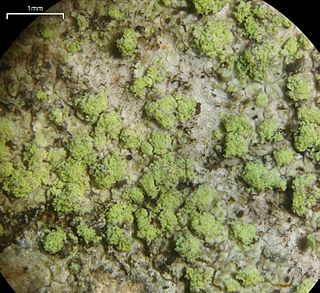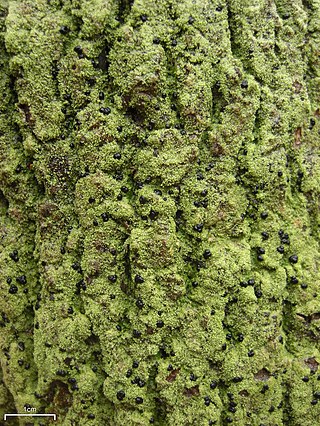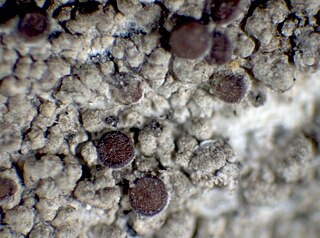
Biatora is a genus of lichens in the family Ramalinaceae. First described in 1817, the genus consists of crustose and squamulose lichens with green algal photobionts, biatorine apothecia, colorless, simple to 3-septate ascospores, and bacilliform pycnospores. According to the Dictionary of the Fungi, the genus contains 42 species that are widely distributed in temperate areas.

Bacidia is a genus of lichen-forming fungi in the family Ramalinaceae. The genus was circumscribed by Giuseppe De Notaris in 1846.
Biatora epirotica is a species of corticolous (bark-dwelling) lichen in the family Ramalinaceae. Found in specific regions of the Balkans and Turkey, it was described as new to science in 2011 by lichenologists Christian Printzen and Toby Spribille.
Biatora aureolepra is a species of lichen in the family Ramalinaceae, first found in inland rainforests of British Columbia.
Biatora ligni-mollis is a species of lichen in the family Ramalinaceae, first found in inland rainforests of British Columbia.
Coppinsidea vainioana is a species of crustose lichen in the family Ramalinaceae. It occurs in Europe, where it grows on the bark of pine trees.
Heteroplacidium zamenhofianum is a species of lichenicolous (lichen-eating) lichen in the family Verrucariaceae. As a juvenile, it is parasitic on some members of the lichen genus Staurothele, but later becomes independent and develops a brown, crustose thallus. Characteristic features of the lichen include its dark brown, somewhat squamulous thallus and relatively small ascospores. It is widely distributed in Europe and North America.
Biatora oxneri is a species of corticolous (bark-dwelling) lichen in the family Ramalinaceae. It is found in the Russian Far East and in South Korea.
Biatora pacifica is a species of corticolous (bark-dwelling), crustose lichen in the family Ramalinaceae. It is found in Russia, Japan, and South Korea, where it grows along the Pacific coast. It inhabits the bark of a variety of coniferous and deciduous plants.
Biatora radicicola is a species of corticolous (bark-dwelling) and saxicolous (rock-dwelling), crustose lichen in the family Ramalinaceae. It is found in various locations in Europe, where it grows in sheltered and humid microhabitats, often on exposed root bark at the base of trees.
Biatora terrae-novae is a species of corticolous (bark-dwelling) crustose lichen in the family Ramalinaceae. It is found in Newfoundland and Labrador, Canada. It was formally described as a new species in 2016 by lichenologists Christian Printzen and John McCarthy. The type specimen was collected along the Route de mon grand-père Trail in Port au Port Peninsula, where it was found growing on moss at base of a stem of balsam fir. The species contains argopsin, and norargopsin as major and minor lichen products, respectively.

Xanthoparmelia plittii is a lichen which belongs to the Xanthoparmelia genus.

Biatora pontica is a species of corticolous (bark-dwelling), leprose lichen in the family Ramalinaceae. It is a widely distributed species, having been recorded in Africa, Asia, Europe, and North America.

Myochroidea is a genus of lichen-forming fungi of uncertain familial placement in the order Lecanorales. It has four species of grey or brown-grey crustose lichens.

Tor Tønsberg is a Norwegian lichenologist who has made significant contributions to the taxonomy, chemistry, floristics, and phytogeography of lichens and lichenicolous fungi. Throughout his career, he has described more than one hundred species and genera new to science, advancing the knowledge of lichens in Europe and North America.
Biatora toensbergii is a species of corticolous (bark-dwelling), crustose lichen in the family Ramalinaceae. It is found in Norway and northwestern North America.
Biatora bacidioides is a species of corticolous (bark-dwelling), leprose lichen in the family Ramalinaceae. It was formally described as a new species in 2003 by the lichenologists Christian Printzen and Tor Tønsberg, from specimens collected from Picea orientalis forests of north-eastern Turkey. It was recorded from Ukraine in 2018.
Biatora pausiaca is a species of corticolous (bark-dwelling), leprose lichen in the family Ramalinaceae. Found in the United States, it was formally described as a new species in 2003 by the lichenologists Christian Printzen and Tor Tønsberg. Its ascospores are 3.5–6.5 μm wide, and it does not contain any lichen products detectable with thin-layer chromatography. It is closely related to Biatora vezdana; these two species form a clade that itself has a sister relationship with Biatora radicicola.





